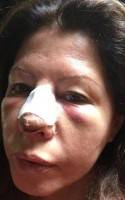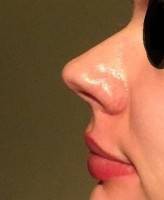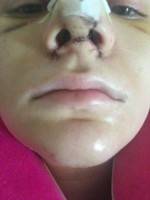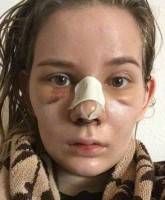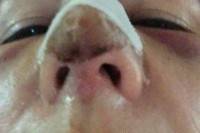Risks of rhinoplasty
Risks of nasal hump removal with nose job (rhinoplasty)
Drooping of the nose is a natural consequence of aging and happens irregardless of surgery. Although I am not aware of any study that has followed this process longterm, my experience would tell me that noses that are operated upon tend to sag LESS than natural noses (my opinion) over time.
Risks include but are not limited to infection, bleeding, hematoma, visibile or palpable irregularities, pain, tenderness, numbness, septal hematoma or fistula, epistaxis, synechia, vestibular stenosis, audible or restricted nasal obstruction, need for subsequent revisionary procedures, non-union, malunion, and inability to guarantee any specific cosmetic result. (Otto Joseph Placik, MD, Chicago Plastic Surgeon)
Risks and Additional Surgery associated with Shaving a Nasal Hump Down
The back of the nose (hump) is made of a variable combination of the 2 upper lateral cartilages and 2 nasal bones with variable contribution from the perpendicular septum. When shaving the hump down variable elements of these components are affected. If a small shave is involved and the side walls are still together / not separated, then in-fracturing of the side walls may not be needed. If the shaving down / rasping takes a segment of the roof off and the walls are separated, they need to be moved together by breaking the side walls and pushing the tops together. Failing to do so would leave you with a flat, wide nose – called an “Open Roof Deformity”. In the process of shaving the hump, the septum which appeared to be straight may have a deviation in it deeper and require straightening.
This may require one of several technique, most likely placement of Spreader Grafts. ALL operations have unavoidable complications despite everything we do. If you are not willing to accept the complications despite how rare they may be – do not have the surgery. (Peter A. Aldea, MD, Memphis Plastic Surgeon)
Risks of Rhinoplasty Hump Removal
There are risks associated with any surgery. In some patients, actually building up the nose instead of taking down the hump is more appropriate. For a straight forward hump removal, an ‘inverted-v’ deformity of the nasal bones and collapse of the midvault are possible if the procedure is not done correctly.
‘Inverted-V’ is where the bone is shaved off and created a hollow over the bones on the top portion of the nose. Over time, the overlying skin sinks in. To correct this, at the time of surgery, the bones are broken and allowed to fall in so that the gap does not form.
The midvault collapse is easily corrected at the time of surgery as well. I would suggest visiting a surgeon who specializes in rhinoplasty or at least facial surgery to ensure your best possible results. (D.J. Verret, MD, Dallas Facial Plastic Surgeon)
Shaving down nose hump
The previous answers have quite adequately explained the minimal risks in ‘shaving the dorsal hump’ down. From the posted photos it appears you have a computer imaged before & after?
If yes than you already have the answer to your question from an in person consult. We as experts can not add much more. (Darryl J. Blinski, MD, Miami Plastic Surgeon)
An experienced Rhinoplasty Surgeon can remove a dorsal hump without significant risk.
There are complications associated with every surgery, including Rhinoplasty Surgery. Removing a dorsal hump is one of the most common conditions I treat with Rhinoplasty Surgery. Patient satisfaction is typically very high. You would likely benefit from slight tip projection and support that would be performed at the time of your Rhinoplasty Surgery. (Eric M. Joseph, MD, West Orange Facial Plastic Surgeon)
Nasal hump deformity
A small traumatic nasal hump can be safely filed down with very little risk associated with the procedure. However, sometimes depending upon how big the bump is an “open roof” can result that requires the bones to be gently infractured at the same time to close the open roof once the hump is taken down. (Scott Trimas, MD, Jacksonville Facial Plastic Surgeon)
A small hump can be shaved down with virtually no risk.
Sometimes you need to reset the nasal bones because they would be too far apart if this were not done. In more than 30 years of rhinoplasty, I have not had any complication from hump removal. (Toby Mayer, MD, Beverly Hills Facial Plastic Surgeon)
Humps on the nose can be shaved down but often patients need more
The hump on a nose can be shaved or filed down. However, often patients require more. If it is a large hump, taking off this “top of a pyramid” would need to be closed by mobilizing the nasal bones through what we call osteotomies. In some patients, less hump may be removed by adding to the area above the hump called the radix. This would leave a stronger profile. I feel computer imaging is a great tool to help visualize the potential results. (Steven J. Pearlman, MD, New York Facial Plastic Surgeon)
Risks to nasal hump removal
Risks to this kind of asal surgey are mostly having to do with getting the shape just right. Possible irregularity, slight bumps, slight residual hump, etc. Also this may require repositioning of the sides of the nose to prevent a flat surface over the bridge once the hump is shaved. There is also the risk of having too much shaved.
There are also always risks of bruising, bleeding, pain, or infection as is true with any surgical procedure. Most of these risks can be minimzed by having the procedure performed by a board certified plastic surgeon. As far as long term risks there are very few.
Rhinoplasty does not result in long term dropping nose, loose skin, or the other problems you mentioned. It should be a permanent long term result. The vast majority of patients only need 1 rhinoplasty during their lifeltime. (Robert B. Pollack, MD, La Jolla Plastic Surgeon)
